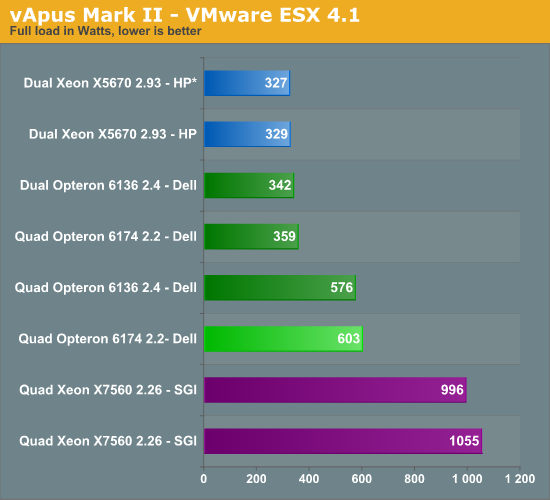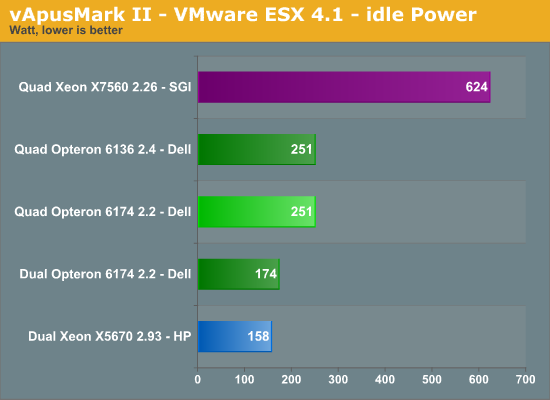Server Clash: DELL's Quad Opteron DELL R815 vs HP's DL380 G7 and SGI's Altix UV10
by Johan De Gelas on September 9, 2010 7:30 AM EST- Posted in
- IT Computing
- AMD
- Intel
- Xeon
- Opteron
Power Extremes: Idle and Full Load
Now that we have real OEM servers in the lab for all platforms, we can finally perform a decent power consumption comparison. All servers have 64GB and the disk configuration is also exactly the same (four SSDs). In the first test we report the power consumption running vApus Mark II, which means that the servers are working at 95-99% CPU load. Please note that although the CPU load is high, we are not measuring maximum power: you can attain higher power consumption numbers by using a floating point intensive benchmark such as Linpack. But for virtualized—mostly integer—workloads, this should be more or less the maximum power draw.
We test with redundant power supplies working. So the Dell R815 uses 1+1 1100W PSUs, the SQI Altix UV10 uses 2+2 850W PSU and the HP uses the 1+1 460W PSUs.

You might think that the four 850 W PSU (2+2) are a serious disadvantage for the SGI server, but they are an advantage. The DELL and HP servers split their load over the two PSUs, resulting in somewhat lower efficiency, while the redundant PSUs of the SGI server consume exactly … 0 Watt. The power distribution board of the SGI Altix UV 10 /QSSC-4R has a very “cool” feature called “cold redundancy”. Although the redundancy is fully functional, the 2 redundant PSUs do not consume anything until you pull the active PSUs out.
The Dell R815 consumes less than two HP DL380 G7s, so the performance/watt ratio is competitive with the dual Xeon platform and without any doubt superior to the quad Xeon platform. If you compare the R815 with two Opterons with the HP DL380, you will notice that the R815 server is very efficient . The dual Opteron is hardly consuming more than the HP dual Xeon server while it has an 1100W PSU (not ideal when you are consuming only 360W) and contains of course a slightly more complex quad socket board. The quad socket R815 server is thus very efficient as the difference with a dual socket Xeon server is minimal.
Comparing the dual with the quad Opteron 6174 power numbers, we notice a relatively high increase in power: 244 Watt. So for each Opteron that we add, we measure 122 W at the wall. This 122 W includes a few Watts of PSU losses, VRM and DIMM wiring losses. So the real power consumed by the processor is probably somewhere between 100 and 110W. Which is much closer to the TDP (115W) than the ACP (80W) of this CPU.
Idle power measurements are hardly relevant for consolidated virtualized environments but they are a very interesting point of reference.

As you can see, it is not only the 130W TDP Xeon 7560 that make the SGI Altix UV10/QSSR-4R consume so much. We measure 372W difference between idle and full load, which is about 93W per CPU. That is not a huge difference if you consider that the difference is 350W for the four Opterons, and 170W for the two Xeons 5670. The Xeon 7500 CPU is capable of power gating the cores and will not consume much in idle. So we may say that the difference is not made by the CPUs: all CPU will consume in the range of 90-110W.
The problem is the complexity of the server. The QSSC-4R/ SGI Altix UV 10 pays a price for its scalability and serviceability: the memory riser boards alone consume almost 20W per board. So eight memory boards can add up to 160W. Being able to power 11 PCIe cards means that your power budget grows even more as the complexity of the I/O board is higher and the engineers have to size the power supply for the use of many more I/O cards and memory. The result is that the performance ratio of the quad Xeon 7500 is rather mediocre: you need three times the power of an HP DL 380 G7 and you only get twice the performance. At idle, it is even worse.
The Opteron 6174 needs a bit more power than its 80W ACP tag promises, but the performance/Watt ratio is very good, on par with the HP DL 380 G7. You need almost two HP DL380 G7 to achieve the same performance, but the DELL R815 needs 10% less power than two HP DL380 G7. So the DELL R815 is definitely a match for two DL380 G7s in the performance/watt category. And it beats two HP DL380 G7 with a healthy margin in other departments: CAPEX ($14000 with 128GB versus 2 x $9000 with 64GB), OPEX costs (only one machine to set up and manage), and rack space (2U vs 4U).
But… maximum power and minimum power are not very realistic. How about a real world scenario?










51 Comments
View All Comments
Chrisrodinis - Thursday, February 27, 2014 - link
This article is about Dell servers in 2010. For comparison purposes here is an overview of a Dell PowerEdge M420 Blade server. This video has cool effects with upbeat production values. Please check it out, thanks: https://www.youtube.com/watch?v=iKIG430z0PI